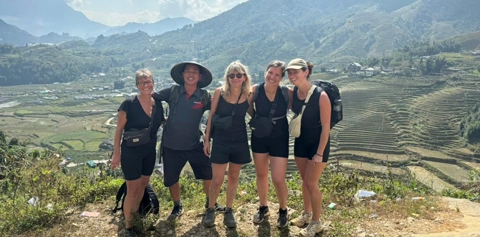How To Get Around Vietnam: Pros and Cons?
Getting around Vietnam is an adventure in itself, with a variety of transportation options to suit every traveler’s style. There’s something for every preference, from modern conveniences like ride-hailing apps and trains, to more local experiences such as motorbikes and boats. If you’re visiting this beautiful country for the first time and find yourself wondering how to get around Vietnam, we’ve got you covered. In this guide, we'll break down the 10 ways to get around Vietnam, as well as give you the pros and cons for each option, so you can find the one that suits your travel style best.
#1 Plane
First up, the plane. It's certainly the fastest way to reach your destination. You can get to most cities in the country in around two hours. This makes flights to and around Vietnam an excellent choice for travelers who don’t have much time. This is the best way to travel in Vietnam from North to South.
In the domestic air transport market, Vietnam Airlines remains the biggest and best airline in Vietnam. Its domestic flights are frequent and cover the country's major cities. Its services are of good quality and reasonably priced, whether it's for domestic, regional, or international routes. There are also low-cost airlines such as Vietjet Air, Bamboo Airways, and Jetstar Pacifique Airlines, which offer cheaper but less regular flights and are more prone to delays.
Cities in Vietnam are well served by airlines. There are 15 national and 7 international airports, spread over the 3 regions from north to south. Most international flights arrive at Noi Bai (Hanoi) and Tan Son Nhat (Ho Chi Minh City) airports, making them gateways to other cities in Asia.
Please note that for domestic flights, checked baggage must not exceed 20kg for economy class (and 30kg for business class). The maximum weight for carry-on is 7kg. In the event of excess weight, you need to pay for the extra kilos for around 2 USD/kg. Baggage fees and policies vary from airline to airline. Low-cost carriers generally charge extra for luggage or preferred seats.
Pros: The fastest way to get around in Vietnam; there are frequent flights throughout the day.
Cons: More expensive than other options; carbon footprint.
If you are arriving in Vietnam by international flight, you will need a visa to enter the country, or you may qualify for a visa exemption.
#2 Train
Traveling around Vietnam by train offers a safe and relatively affordable way to explore the country's picturesque landscapes, from rice paddies and quaint villages to majestic mountains and roaming buffalo.
Vietnam's main train line, spanning from Hanoi through Ninh Binh, Hue, Danang, and Nha Trang, to Ho Chi Minh City (Saigon), covers 1,730 km and takes approximately 29 to 33 hours. For shorter trips, consider routes like Hanoi to Sapa (280 km in about 8 hours) for exploring the northern highlands or Hanoi to Hai Phong (2.5 hours) for a quick visit to Vietnam's largest port.
When choosing seats or cabins, options range from basic benches to 6-berth cabins with bunk beds, and VIP cabins with 4 beds. Night trains are practical for saving on accommodation costs and maximizing travel time, especially on longer routes like Hanoi to Sapa or Nha Trang to Saigon. Keep in mind to pack warm clothing as train air-conditioning can be chilly at times.
Pros: Stunning views of Vietnam's countryside; sleeper cabins make long journeys more comfortable than buses.
Cons:
Journeys between major cities like Hanoi and Ho Chi Minh City can take up to 32 hours.
Trains can be noisy and vibrate due to outdated infrastructure.
#3 Buses
Bus transport is a popular and budget way to get around in Vietnam. There are several types of buses in Vietnam, ranging from local buses to luxury and tourist buses.
Local buses
As far as local buses are concerned, they let you travel within cities or cover short distances to the suburbs. They are often crowded with locals, and not very comfortable during rush hour. This means of transport is best suited for those who have already spent a few months in Vietnam and are familiar with the country's traffic conditions.
They are, however, suitable for short trips around town and for travelers on a budget. Local bus prices vary according to route and city. However, they are often the cheapest, costing from 7,000 VND (around €0.20) per trip.
Sleeper buses
Sleeper buses are often a popular choice to get around in Vietnam as they offer a compromise between comfort and cost, aimed at those wishing to go from city to city.
Popular bus companies include Phương Trang (Futa Bus), The Sinh Tourist, and Hanh Cafe,... Ticket prices vary according to distance traveled, but are generally cheaper than domestic flights. However, it's important to note that bus journeys can take longer than flights, especially to remote destinations.
Some operators offer more expensive “Limousine” and “VIP” options, as well as private cabins. These options are equipped with full amenities, including WiFi, power sockets, reclining seats, on-board meals, air conditioning, and toilet facilities.
Tourist buses
Sightseeing buses, especially in Hanoi or Ho Chi Minh City, are designed for visitors who want to see as many sites as possible in as little time as possible. Hop On Hop Off buses, for example, allow you to “hop off” as often as you like at famous sites, and then “hop on” the next bus. It's a practical option for those who don't know the city they're visiting very well, and want to get around at their own pace.
Pros: Very affordable; sleeper buses available
Cons: May be uncomfortable, takes longer, may not arrive on time
#4 Taxi
In Vietnam, you'll find many cab companies. For many travelers, cabs are the easiest way to get around in Vietnam quickly and safely.
In general, you pay the amount shown on the meter at the end of the journey. It's also possible to negotiate a flat-rate fare in advance. The price remains very reasonable: expect around 13,000 dongs (0.5 Euro) per kilometer.
As in most countries around the world, alongside honest cabs, there are also fake cabs lurking everywhere. So beware of rigged meters (some meters are manipulated to accumulate charges faster than expected). To avoid cab rip-offs, use only recognized agencies, of which the following is an exemplary list:
Mai Linh Taxi 024 38 33 33 33 (Hanoi) and 028 38 38 38 38 (Saigon)
Cab Group 024 38 53 53 53 (Hanoi)
G7 cab 024 32 32 32 32 (Hanoi)
Cab VinaSun 028 38 27 27 27 (Saigon)
Saigon cab 028 38 23 23 23 (Saigon)
You can also opt for XanhSM, a ride-hailing app that offers electric rides. A XanhSM cab is not only cheaper than conventional taxis but also eco-friendlier.
Pros: Taxis are an easy and safe way to navigate the cities without dealing with the chaotic traffic.
Cons: Fake taxis and rigged meters are not uncommon; Compared to motorbike taxis, cabs are more expensive.
#5 Motorbike
Motorbikes are the most common transportation in Vietnam (there are around 45 million motorbikes circulating throughout the country), making them an integral part of people's lives.
If you want to get around the city more quickly, you can use a moto-taxi (xe ôm). This costs much less than a regular taxi. It's easy to find xe ôm anywhere in town at a particularly reasonable price. Many travelers appreciate this mode of transport, as it gives them a unique experience immersed in local traffic.
You can rent a motorbike in most cities, giving you the freedom to explore on your own schedule. Riding a motorbike in Vietnam offers a thrilling, immersive experience, but it's important to be cautious. The traffic can be intense, so always wear a helmet and check the condition of any rental before hitting the road.
Note: For your safety, you need to know the country's traffic rules and flow. Check the motorcycle very carefully before renting, and remember that you need a permit to drive in Vietnam. Motorbikes are a great way to get a full, immersive experience, but if you're not confident on two wheels, you may want to stick to taxi services or hire a local guide to show you around.
Pros: Common transportation; ideal to navigate the streets of Vietnam; affordable; lets you explore the country’s hidden corners.
Cons: May be hard for those without experience; requires a permit.
#6 Apps
Ride-hailing apps like Grab have become an incredibly popular way to get around in Vietnam, providing an easy and convenient way to get around major cities. With just a few taps on your phone, you can book a car or motorbike, track your driver in real time, and pay through the app, either in cash or via a linked card. Other popular apps include XanhSM, Gojek and Be, but Grab remains the dominant player.
Available in cities like Hanoi, Ho Chi Minh City, Da Nang, and more, these services offer an alternative to traditional taxis and motorbike rentals, catering to both tourists and locals alike.
Booking a ride is quick and easy through the app, with no need for negotiation or cash if using in-app payment. The app provides an upfront fare estimate, so you know the cost before booking. You can choose between car rides or motorbike taxis (GrabBike) depending on your preference.
While widely available in major cities, ride-hailing services are less common in smaller towns and rural regions. Some drivers may not speak English, which can lead to communication challenges if you're unfamiliar with Vietnamese.
Pros: Affordable, easy, many rides available throughout the day.
Cons: Not common in rural areas.
#7 Cyclo (cycle-rickshaw)
For short distances, getting around with non-motorized, environmentally-friendly means of transport, such as cyclo, is a real pleasure. Cycle rickshaws can be found in tourist cities such as Hanoi, Ho Chi Minh City, Hoi An, and Hue; they are the ideal way to visit historic centers and discover local life at a slow pace.
Once popular with the rich and noble, you can now pay a small fee, get to many places, and take your time to enjoy all the sights. Getting around with a rickshaw has also been hailed by many as one of the most unique means of transport worth experiencing.
Getting around town in Vietnam with a rickshaw is fun. You won't be sitting in a stuffy box, and you won't have to worry about sun or rain: the rickshaw has a folding roof just in case, and you'll have friendly drivers to take you to different corners of the city.
As this means of transport is mainly used by tourists, drivers tend to charge exorbitant sums, so negotiate patiently and fix the price before you get on board.
Pros: Fun, ecological
Cons: Only available in some cities; can only contain 1 person (2 max) per trip; you may get overcharged
#8 Bike
Biking is a fantastic way to explore Vietnam at a leisurely pace, especially in cities with less traffic like Hoi An, Hue, or the countryside around Mai Chau and Ninh Binh. Cycling allows you to experience local life up close, from passing by rice paddies to pedaling through charming villages.
The Mekong Delta, the countryside around Hue and Hoi An, Phong Nha Ke Bang Park, Halong, Mai Chau, Pu Luong, Ba Be Lake and even parts of Hanoi are all great places to discover by bike.
Bicycles can easily be rented in these places. Rentals are generally around 40,000 to 80,000 VND per day (about $2-$4). Several hotels in Hoi An, Ninh Binh, and Mai Chau even make bicycles available to their guests free of charge.
Pros: Eco-friendly and affordable, lets you explore places inaccessible by car.
Cons: Limited to short distances; may be uncomfortable in harsh weather
#9 Boat
Boat travel is an iconic and scenic way to get around in Vietnam, sometimes necessary, especially in regions like the Mekong Delta, Halong Bay, and Ninh Binh. Whether you’re cruising through limestone karsts or floating past vibrant river markets, boats offer a unique perspective on the country’s waterways. From luxurious overnight cruises to simple rowboats, there are various options depending on your destination and travel style.
In the north, excursions in small boats to Ninh Binh-Tam Coc, or a visit to the Perfume Pagoda near Hanoi, are very popular. In Halong Bay, there's a wide choice of 1 to 3-day cruises. Aboard comfortable junks, you can spend the night in well-appointed rooms overlooking the bay. This unforgettable experience is one of the highlights of any trip to Vietnam.
The Mekong Delta in South Vietnam has long been famous for its network of canals, arroyos, rivers, and riverbanks. A beautiful boat trip along these waterways allows you to discover fascinating vegetation in depth, as well as the local villages. Southern Vietnam is also the starting point for visiting the offshore islands of Phu Quoc and Con Dao. You can also head for Phnom Penh, the Cambodian capital just 200 km from Ho Chi Minh City.
Pros: Stunning views; access to areas unreachable by road; many boat cruises designed for relaxation
Cons: Limited to waterways; motion sickness; luxury boat cruises can be quite expensive
#10 Car / Organized tour
Foreign travelers are usually advised against self-driving in Vietnam. It’s hard to find self-drive rental cars and a hassle to get an eligible driving license. It's best to rent a car with a driver through an agency.
Joining an organized tour is a convenient and stress-free way to get around in Vietnam, especially if you're short on time or want everything arranged for you. Tours can range from single-day excursions to multi-day packages, covering everything from city sightseeing to adventure activities like trekking, caving, and cultural experiences. Available in all destinations, organized trips provide guided experience, local insights, and include transportation, meals, and accommodations.
Pros: Hassle-free, local expertise, time efficient
Cons: Organized tours often cost a bit more.
There you have it, top 10 ways to get around Vietnam ! Whether you prefer the ease of an organized tour, the thrill of a motorbike ride, or the relaxation of a boat cruise, each mode of transport offers its own unique perspective of the country. If you need help planning your itinerary, or are interested in booking a guided tour, feel free to contact Vietnam Original Travel!
>>> Highlights of Vietnam 20 Days
>>> Top 15 Most Beautiful Islands in Vietnam—A Complete Guide for Nature & Adventure Lovers
Send us your comments about : How To Get Around Vietnam: Pros and Cons?
Required fields *
You might also be interested
Travel ideas
Need some inspiration? Discover some of the best tours in Vietnam, which are highly appreciated by our clients. An excellent starting point to help you choose the right trip to Vietnam, Laos, Cambodia, Burma or Thailand, whether you are traveling alone, as a couple, as a family or with friends.
And because this trip is yours, feel free to customize it as you wish!
Vietnam Cambodia Itinerary 14 Days
Hanoi – Hoa Binh – Mai Chau – Ninh Binh – Halong bay – Hue - Danang – Hoian – Saigon – Ben Tre - Can Tho – Saigon - Siem Reap Angkor - Tonlé Sap - Siem Reap – Ta Prohm - Departure
Vietnam 14 Day Itinerary
Vietnam 14-day itinerary covers the country’s top highlights and quintessential experiences for an unforgettable journey.
Honeymoon Tour Pakcages In Vietnam 12 Days
Saigon Arrival - City Tour – Mekong Delta – Danang – Hoian - by flight - Da Nang – Hanoi - by flight – Halong - overnight on junk – Departure
Authentic Hoang Su Phi Trekking Tours
Hoang Su Phi trekking tours take you to stunning terraces, meet few tourists, connect with locals and enjoy authentic culture.
Best Nha Trang Beach Tour 4 Days
Saigon/Hanoi – Nha Trang relaxation – Saigon/Hanoi – Departure
Mekong Delta Bike Tour Itinerary 7 Days
Cycle through the Mekong Delta in 7 days, discovering floating markets, orchards, craft villages, and tranquil green islands.
Are you interested in this tour?






































Comment